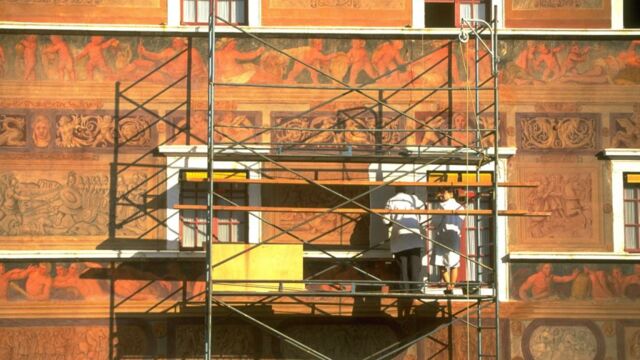Hidden Renaissance-era frescoes discovered at Prince's Palace of Monaco

Workers have discovered hidden Renaissance-era frescoes during restoration at the Prince’s Palace of Monaco.
The Prince's Palace of Monaco has finally reopened to the public after several years of restoration. During the works, restorers discovered a series of Renaissance-era frescoes that have been hidden for hundreds of years.
Discover our latest podcast
'A Renaissance palace'
Restoration first began in 2013, but it wasn’t until 2015 when workers found the hidden frescoes. They were discovered underneath the lunettes and vaulted ceiling of a loggia in the courtyard, which had been repainted in the 19th century. Spanning 600m2, the frescoes depict scenes from the Twelves Labours of Hercules, allegorical figures, and decorative elements. Thus, the loggia is now called the Galerie d’Hercule.
More under this adMore under this adIt is thought that they were painted by Genoese artists during the 16th century. This is because of both the style of the works and the use of lime-based plaster. The frescoes were later covered up, the reason for which is unknown, and left untouched for decades.
Restorers uncovered stunning Renaissance-era frescoes by accident during routine repairs at the Prince's Palace of Monaco: https://t.co/SfVvt1KH6Gpic.twitter.com/B26t4bVYbl
— Artnet (@artnet) July 4, 2022
Chief conservator-restorer Julia Greiner told Artnet News:
This discovery places the Grimaldi family and Palace of Monaco within a new art historical context as a Renaissance palace. The discovery has ignited numerous research projects including conservation and sustainability which have been inspired through his sovereign highness, Prince Albert II’s interest and dedication to environmental issues. Furthermore it has brought together a pluridisciplinary team of approximately 40 specialists that have worked on this project for the last 8 years.
More significant artworks on view
Frescoes have also been found in other areas of the palace. In what was formerly known as the Salon Matignon, an electrician inadvertently revealed a medallion painted on the ceiling that depicts the mythological abduction of Europa by Jupiter. Consequently, the room has been renamed the Chamber of Europe. Meanwhile in the Throne Room, a large-scale fresco portraying Ulysses in Nekuia, the signs of the Zodiac, and the months’ labours, was also discovered in 2020.
More under this adMore under this adThe palace with its newly-discovered frescoes reopened on 1 July and will remain open until 15 October 2022.
Read more:
⋙ World's 'deepest shipwreck' discovered in the Philippines Sea
⋙ Ancient sex toy discovered by archaeologists in Poland (PHOTOS)
⋙ Remarkably preserved 2000-year-old Roman temple discovered in Netherlands